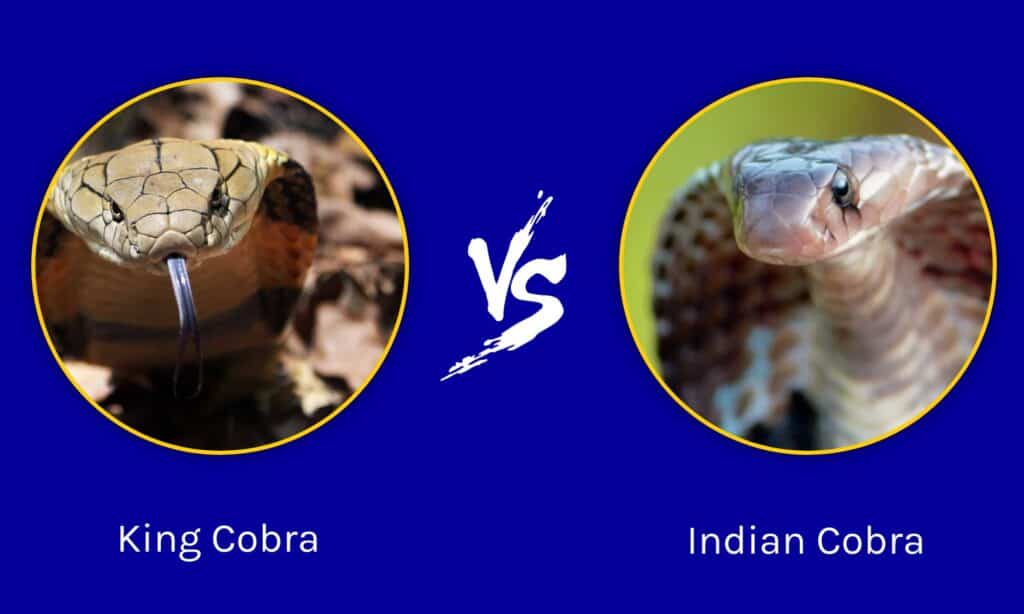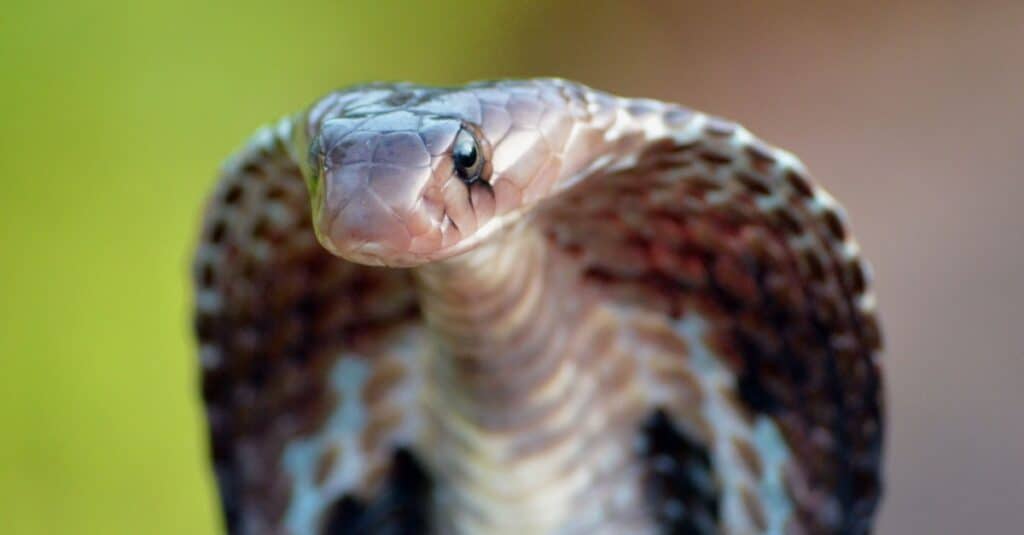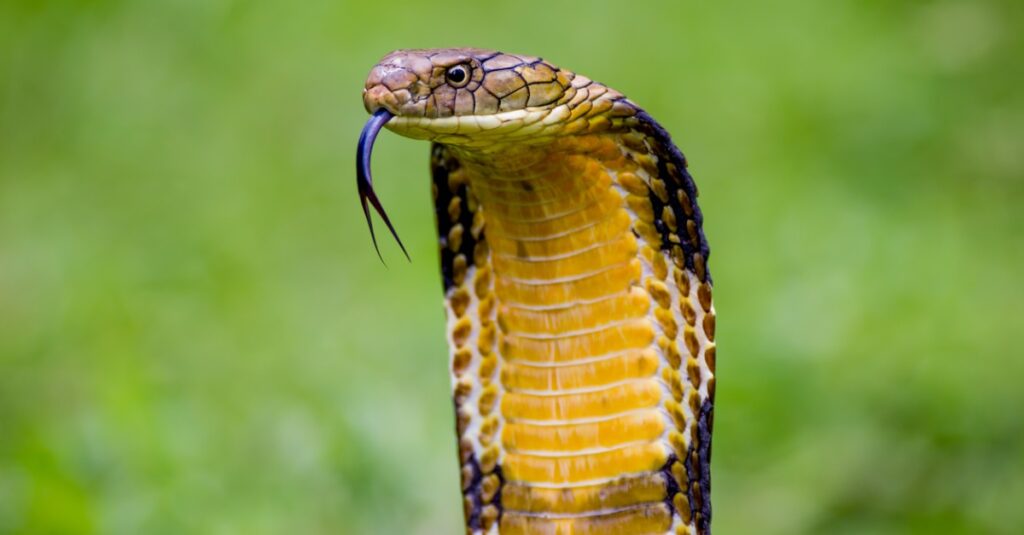When most people think of a long, hooded, hissing snake, they imagine a king cobra. These highly venomous snakes are known for their ability to kill other animals with ease. However, they are not the only cobra or even the one that is most hazardous to human life. The Indian cobra is a member of the “Big Four”, the four snakes that are responsible for most deaths in the world. How are these snakes different? We’re going to take a quick look at a king cobra vs Indian cobra comparison and show you how these snakes differ, and which one is deadliest.
Comparing a King Cobra and an Indian Cobra

| King Cobra | Indian Cobra | |
|---|---|---|
| Size | Weight: 10lbs-15lbs Length: 10ft-19ft | Weight: 2.5lbs-6lbs Length: 4ft-7ft |
| Venom Strength | – Long fangs (0.5in) deliver up to 1000mg of venom – LD50 of 1.28mg/kg – A single bite can kill 11 humans | – Injects 170-250mg of venom – LD50 of 0.56 mg/kg – Kill about 15,000 people per year – A single bite can kill 10 people |
| Fangs | – Fangs are fixed instead of folding – 0.5 inches – They bite and hold on, chewing a little | – Short, fixed fangs – 0.3in – Bite and use a chewing motion |
| Location | – Indian subcontinent and Southeast Asia | – Indian subcontinent |
| Family | – Ophiophagus hannah – Not a true cobra | – Naja naja – True cobra |
The Key Differences Between a King Cobra vs Indian Cobra

Indian cobras are responsible for thousands of deaths every year
©iStock.com/insaneDynamix
The greatest differences between a king cobra and an Indian cobra are their size, venom potency, and the number of people they kill per year. The king cobra can grow upwards of 19ft long and weighs 15lbs, has enough venom to kill 11 people in a single bite, and rarely kills any humans, but an Indian cobra grows 7ft long, kills about 15,000 people per year, and has enough venom to kill 10 people in a single bite.
These snakes have some similarities in terms of the way they look, but they also differ in very significant ways. We’re going to compare these reptiles in five ways to show just how unique they are from each other.
King Cobra vs Indian Cobra: Size
King cobras are bigger than Indian cobras. These snakes can weigh 15lbs and grow 19ft long. They are the largest venomous snake in the world. The Indian cobra is substantially smaller, weighing just 6lbs at the high end of their average and growing about 7ft long in most cases. However, larger Indian cobras measuring about 10ft long have been found.
King Cobra vs Indian Cobra: Venom Strength
The king cobra’s venom is weaker than that of the Indian cobra. Nevertheless, a single bite from a king cobra can kill more people than an Indian cobra because of the vast amount of venom they inject. A king cobra will inject up to 1,000mg of venom per bite on their foes. The Indian cobra only injects about a quarter of that amount, 250mg at the maximum.
This king cobra venom is capable of killing 11 humans with a single bite, and the Indian cobra can kill about 10 people with a single bite. Still, if we compare the LD50 of both animals, the measure of venom that kills 50% of all participants, the Indian cobra’s venom is stronger. The king cobra’s LD50 is 1.28mg/kg and the Indian cobra’s LD50 is 0.56mgkg. In this case, the lower the number, the more potent the substance!
The king cobra rarely kills humans. Instead, they will scare them away by spreading their hood and will only bite if they are in true danger. Indian cobras are more skittish, smaller, and more prone to biting. These snakes kill up to 15,000 people per year!
King Cobra vs Indian Cobra: Fangs
The king cobra and the Indian cobra have unique fangs for venomous snakes. They are both have fixed fangs, meaning that their fangs are not retracted or hinged like other snakes. However, the king cobra has much longer fangs, measuring about 0.5in compared to the 0.3in Indian cobra’s fangs.
Both animals inject venom with their fangs, and neither of these snakes are spitting cobras.
King Cobra vs Indian Cobra: Location
The king cobra has a wider range than the Indian cobra. Indian cobras can be found in the Indian subcontinent. They’re not found far outside of that area. On the other hand, king cobras are widely distributed throughout the Indian subcontinent as well as many parts of Southeast Asia.
King Cobra vs Indian Cobra: Family
The Indian cobra’s scientific name is Naja naja. This snake is a true cobra as a member of the Naja genus. The king cobra, despite its name, is not a true cobra. This snake’s scientific name is Ophiophagus hannah. However, the king cobra has many things in common with the true cobras including its fangs, venom, threat display, and ability to produce a hood by spreading its ribs and muscles.
In fact, most people confuse the king cobra for the Indian cobra. Nevertheless, they are distinct creatures that have many differences as we’ve shown here.
King Cobra vs Indian Cobra: Who Would Win in a Fight?

The king cobra is the longest venomous snake and specializes in eating other snakes
©iStock.com/takeo1775
A king cobra would win a fight against an Indian cobra. The king cobra and the Indian cobra have a certain measure of resistance against one another’s venom as fellow elapids. As a result, size, the amount of venom injected per bite, and the size of fangs would play a larger role in this fight. The king cobra is far larger, more powerful, and has bigger fangs than the Indian cobra.
In the worst-case scenario, both snakes would envenomate each other too much for their resistance to help. In theory, the larger snake is going to live longer than the smaller. No matter how we slice it, it seems more likely that the king cobra would win this fight. Otherwise, both snakes end up dead, but the king cobra has a short time to celebrate its victory.
These are two very dangerous snakes. However, the Indian cobra is far deadlier to human beings. They kill thousands of people every year as one of the Big Four. Hopefully, future efforts and infrastructure will help reduce the number of fatalities and serious injuries caused by venomous snakes in the future.
The photo featured at the top of this post is ©
Discover the "Monster" Snake 5X Bigger than an Anaconda
Every day A-Z Animals sends out some of the most incredible facts in the world from our free newsletter. Want to discover the 10 most beautiful snakes in the world, a "snake island" where you're never more than 3 feet from danger, or a "monster" snake 5X larger than an anaconda? Then sign up right now and you'll start receiving our daily newsletter absolutely free.
Thank you for reading! Have some feedback for us? Contact the AZ Animals editorial team.






